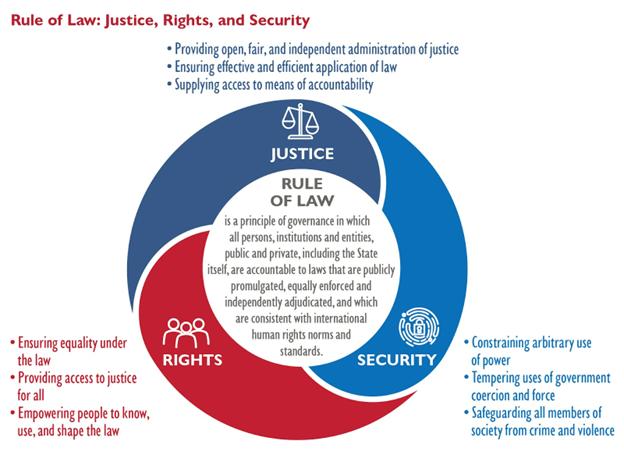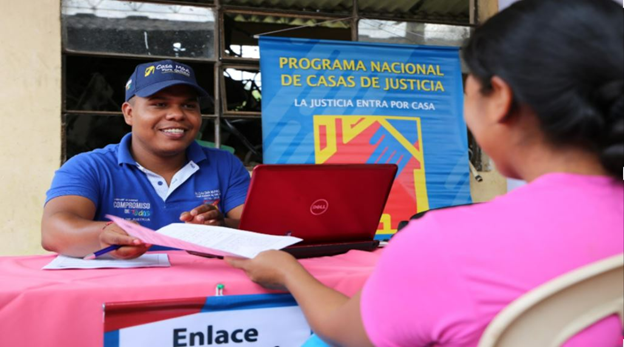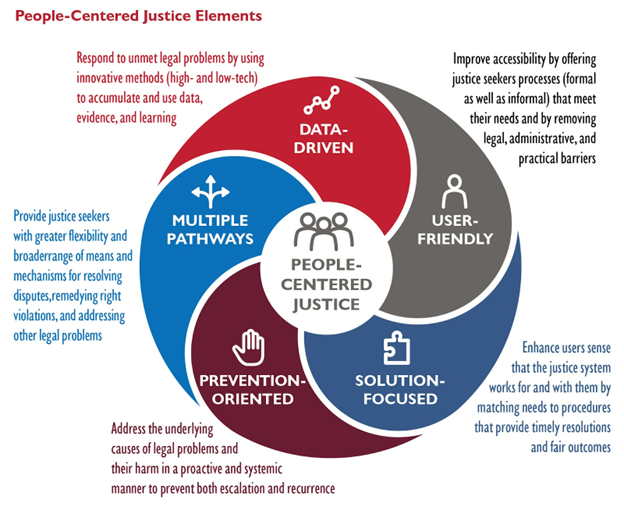|
So you think rule of law is only for lawyers? Not so fast – for USAID, the rule of law is for and about people. Taking a people-centered justice approach to strengthening rule of law helps people develop their own solutions to their everyday challenges, whether those are related to education, business, health, or the legal system. This approach requires engaging people and promoting their leadership to create solutions that work in their environment, and then empowering them to implement those.
A people-centered approach is even more necessary in the current climate in which autocrats have eroded checks on government power. Last year, according to the World Justice Project, the rule of law weakened in more countries than it improved. Respect for fundamental human rights and freedoms is down in three-quarters of countries since 2015, and “Constraints on Government Powers”— including oversight by the judiciary, legislature, and media — have fallen in two-thirds of countries studied.
 Judge Jamila Sapieva, of Bishkek City Court in Kyrgyzstan, has embraced technology solutions, such as automated case management and publishing decisions online, to increase transparency and expand access to justice. (Photo: Olivier Le Blanc/USAID)
To respond to these challenges, USAID launched its first-ever Rule of Law Policy, which builds on more than two decades of programming and learning. The policy, through the people-centered justice approach, formally prioritizes knowledge and evidence. With the implementation of this Policy, USAID renews its commitment to the rule of law and to justice, rights, and security for all.
This edition of the DRG Learning Digest examines the following topics:
- Recent evolution: What does rule of law mean?
- Why people-centered justice matters to promoting rule of law
- Policy into practice: applying people-centered justice to our programming
Please make use of DRG Evidence and Learning Team resources! (See text box at the end.)
Recent Evolution: What Does Rule of Law Mean?
Societies have better development outcomes when they are governed by responsive, predictable, and open systems of justice. In recent years, authoritarian governments have claimed to be acting under the law when in fact they have corrupted the rule of law into rule by law. USAID’s new Rule of Law Policy adopts the UN definition of rule of law as a principle of governance in which all persons, institutions, and entities, public and private, including the State itself, are accountable to laws that are publicly promulgated, equally enforced, independently adjudicated, and consistent with international human rights norms and standards.
 Source: Excerpt from USAID’s Rule of Law Policy
The rule of law sector has evolved significantly over the years. In the 1990s and early 2000s, rule of law programming mainly favored top-down, supply-driven approaches that prioritized, for example, justice reforms driven from within the formal justice system. Strategies were based upon assumptions rather than on people’s views and experiences. Early rule of law programming enabled court reform and institution-building, but left largely unaddressed the needs of the poor and other disadvantaged groups. An initial shift toward people-centricity began in the late 1990s. With increased evidence and innovation, rule of law programming has now evolved to one centered around what people want and need when they seek justice. The OECD developed a framework to rethink traditional approaches and focus justice services to ensure that everyone has access to effective, problem-solving justice, and that justice processes and services are responsive to people’s needs.
People-centered justice places the person affected by the law at the core of the policies, processes, and practices that comprise justice and related systems. It is a data-driven, user-friendly, and solution-focused justice approach that establishes multiple pathways for solving people’s problems, and does so in a way that addresses their specific needs and situations. This approach does not reject the importance of institutions, as both formal and informal institutions remain the primary managers of delivery mechanisms and points of entry into the justice system.
 Source: Excerpt from the USAID Rule of Law Policy.
The 2010s saw a notable shift in policies to take a more bottom-up, broader view of law — including processes, agreements, and traditional justice systems that constitute law for the disadvantaged and serve as the connective social tissue upon which government service delivery is built. The people-centered approach provides new, effective means of fostering justice integration, building cross-sectoral cooperation, and improving the resiliency of people, communities, and countries to respond to current development challenges. In addition to building better justice systems and services, this approach ensures that other services – such as health care, education, and housing – are more responsive to the specific needs of underserved populations at risk of social and economic exclusion. This approach follows The Hague Declaration on Equal Access to Justice by 2030, which outlines a framework for moving from justice for the few to justice for all by emphasizing the need to put people and their legal needs at the center of justice systems, solve justice problems, improve the quality of the justice journey, use justice for prevention, and provide people with means to access services and opportunities.
Why People-Centered Justice Matters to Promoting Rule of Law
Effective justice relies on trust across three domains of government-society interactions – systems, services, and society; this trust is improved by problem-solving interactions and well-functioning feedback loops between them. Evidence suggests that “how individuals regard the justice system is tied more to the perceived fairness of the process and how they were treated rather than to the perceived fairness of the outcome.” An impact evaluation in Liberia found that plaintiffs offered legal aid were significantly more satisfied with case outcomes, paid fewer bribes, and reported larger material gains in terms of household and child food security. Success was even greater for plaintiffs facing poor odds in the customary system, suggesting that large socioeconomic gains can result from improving access to the formal law and improved institutions. Similarly, a study of Chile’s criminal law reforms demonstrated that decreased pretrial detention improved Chileans’ perceptions about crime and violence in regions where reforms were implemented. The success was credited to government commitment combined with concerted and consistent efforts by police, offering a model for other countries implementing similar reforms. An impact study in Mexico revealed that in certain cities judicial reform reduced victimization, increased crime reporting, and increased the probability that the Public Prosecution Office would investigate reported crimes. While in some cities judicial reform lowered trust in the Federal police, this study indicates the importance of more localized and people-centered approaches developed through analysis and engagement with available justice systems to find local solutions that can achieve durable reforms.
Rule of law is not simply about maintaining order, nor is it only about rules or laws. It is a societal commitment to peacefully resolving disputes within a legitimate system, whether those disputes are about health, crime, discrimination, corruption, or other issues. Research from Peru implies that providing access to problem-solving justice for women is not only important for addressing gender-based violence, but also generates inter-generational benefits including increased investments in children’s education and decreased child labor. This study revealed that women’s justice centers in Peru, that mostly employ female officers and whose main purpose is to reduce gender-based violence by providing police and legal services, provided a community-based approach that reduced domestic violence by 10 percent and increased reporting of gender-specific crimes by 40 percent.
 In the wake of Colombia’s peace accord, USAID’s Justice for a Sustainable Peace helped create capacity for justice systems institutions to deliver effective justice services at the local level, and strengthen local civil society organizations to support civic engagement and advocacy. (Photo: Justice for a Sustainable Peace/USAID)
People-centered justice is a dynamic approach that is rapidly growing. A recent contribution to this effort is the OECD Framework and Good Practice Principles for People-Centered Justice which offers a successful model structured around four pillars: 1) designing and delivering people-centered services, 2) governance enablers and infrastructure, 3) people empowerment, and 4) planning, monitoring, and accountability. These pillars focus on understanding and meeting the legal and justice needs of all people as they experience them, regardless of whether the needs have a legal dimension. The goal is to generate fair outcomes and opportunities to contribute to the overall health and well-being of society, inclusive growth, and the quality of democratic governance. This transformative process requires understanding people’s needs and experiences, finding ways to meet those needs, and removing barriers to access. There is no single path to improved rule of law; therefore, practitioners use available evidence – qualitative and quantitative – along with international standards and practices such as these offered by the OECD, to identify reforms that fit with the local context.
The 2019 Pathfinders Task Force Justice for All Final Report makes recommendations to empower people to understand, use, and shape the law, and on how countries can meet people’s justice needs through informal and formal justice services. The report also emphasizes the need for enhanced innovation, smarter financing, and more inclusive partnerships among governmental and non-governmental bodies. In line with these recommendations, USAID’s Rule of Law Policy shifts the paradigm toward the transformation of institutions to secure justice, rights, and security for all, improving justice users' experiences and outcomes while strengthening checks and balances.
USAID's Policy into Practice: Applying People-Centered Justice to Programming
USAID’s approach to people-centered justice builds on more than 20 years of experience implementing rule of law programming and a robust evidence-base. The USAID Rule of Law Terrain Analysis harvests best practices, innovations, and lessons learned from scholars, practitioners, and academics. This learning analysis builds on USAID’s most recent Rule of Law Practitioner’s Guide, which highlighted the importance of collaborative tools in building a more responsive justice system. This analysis makes the case for a people-centered approach with innovative rule of law programming that prioritizes bottom-up legal and non-legal strategies, delivered through collaboration between justice operators, paralegals, and community actors. The USAID-commissioned Rule of Law Evidence Map includes more than 700 studies across diverse geographic areas on rule of law and justice topics, providing an important body of evidence for decision-making on where and how to invest resources. USAID’s Rule of Law Achievements Report highlights the Agency’s achievements based on an analysis of 340 activities in 83 countries from 2005 to 2020, and focusing on activities in 16 countries. The report provides concrete examples in five thematic areas (greater judicial independence; enhanced administration of justice; improved access to and trust in the justice system; enhanced ability to combat crime, corruption, and insecurity; and protection for defenders, women, and vulnerable groups) as well as regional reports highlighting specific projects in the 16 countries. These lessons help USAID to re-envision rule of law programming, particularly the critical links with other areas of development such as global health, climate change, economic development, and labor rights.
 Source: Excerpt from the USAID Rule of Law Policy.
USAID’s Rule of Law Policy prioritizes flexible approaches to ensure sufficient testing, learning, and iteration that identifies justice solutions that can be scaled up. People-centered programming establishes feedback loops among users, institutions, and service providers for continuous learning and evidence-based decision making. Applying policy to programming, USAID facilitates multiple pathways to justice, recognizing that not all legal needs require the intervention of courts. Where appropriate, this includes strengthening informal and customary justice systems, while adhering to international norms and frameworks. Activities remove barriers between justice providers and communities, facilitating inclusive and equitable public participation and oversight.
Programming focuses on diversity, equity, inclusion, and accessibility to adapt to the specific needs of local communities and individuals, using a process of innovation and experimentation to solve people’s legal problems. The wider perspective that the Policy brings allows USAID’s rule of law efforts to leverage policies, frameworks, and evidence to address: gender equality and equity; the role of youth; and the rights of Indigenous Peoples, persons with disabilities, LGBTQI+ persons, and other marginalized groups. The Policy also supports the protection of rights to ensure equality under the law and equitable access to justice for all, as well as improving security by constraining the arbitrary and corrupt exercise of power.
Further Assistance
To learn more about people-centered justice and USAID’s new Rule of Law Policy, contact the DRG Center’s Justice, Rights, and Security Team at ruleoflaw@usaid.gov. Also, don’t forget to check out USAID’s e-learning course Facilitating People-Centered Justice through Rule of Law Assistance.
Recent DRG Learning Events
SBC for DRG Community of Practice: On Nudges and Nudging
One of the most popular social and behavior change (SBC) strategies is the “nudge,” defined as a light-touch intervention which encourages but does not force a certain behavior. On March 16, USAID’s Levi Adelman and Laura Van Berkel reviewed some of the latest evidence and most pressing debates around the use of nudges in DRG programs (link only accessible to USAID personnel). Attendees learned about recent meta-analyses identifying when and where nudges are effective, and discussed when and where nudges are acceptable as well as how they implement them in their work.
DRG Learning Community of Practice: Why More is Not Always Better
Social movements are much more likely to achieve their goals if they reach a certain participation threshold. What, however, enables the growth of social movements toward that threshold in the face of authoritarian repression? On April 7, Laura Adams from Pact, Natalia Forrat from Freedom House, and Sarya Sok from the Department of State joined the DRG Center to present the results of a two-year study of 21 recent attempts to mobilize in authoritarian contexts. The research examines common factors across cases and offers recommendations for practitioners and activists.
Tuesday Group: “Keeping horses in front of (and hooked to) carts: Facts and puzzles in the dynamics of national development”
On April 18, Lant Pritchett joined the DRG Center to discuss his recent paper on "national development." He argues that the question of "what works" and which projects donors and philanthropists should undertake is mostly beside the point of achieving high levels of human wellbeing. High levels of national development are empirically necessary and sufficient for high levels of human wellbeing. The paper finds that "higher order" well-being indicators (like "tolerance") are affected more by governance (state capacity and democracy). However, measures of "electoral democracy" do not contribute greatly to basic well-being indicators when compared to "state capability."
Use Our Resources!
Welcome to the DRG Learning Digest, a newsletter to keep you informed of the latest learning, evaluation, and research in the Democracy, Human Rights, and Governance (DRG) sector. Views expressed in the external (non-USAID) publications linked in this Digest do not necessarily represent the views of the United States Agency for International Development or the United States Government.
Don't forget to check out our DRG Learning Menu of Services! (Link only accessible to USAID personnel.) The Menu provides information on the learning products and services the Evidence and Learning Team offers to help you fulfill your DRG learning needs. We want to help you adopt learning approaches that emphasize best fit and quality.
The Evidence and Learning Team is also excited to share our DRG Learning, Evidence, and Analysis Platform (LEAP) with you. This Platform contains an inventory of programmatic approaches, evidence gap maps, the DRG Learning Harvest, and inventories of indicators and country data portraits - all of which can be very useful in DRG activity design, implementation, evaluation, and adaptation. Some of these resources are still being built, so check back frequently to see what has been newly added.
The DRG Learning Harvest on LEAP is a searchable database of DRG learning products, including summaries of key findings and recommendations, drop-down menus to easily find documents related to a particular country or program area, and links to the full reports on the DEC.
Our friends at the Varieties of Democracy (V-Dem) Institute are also seeking to expand their research partnership with USAID on the complex nature of democracy by inviting research questions from you for V-Dem to work on. If there's a DRG technical question you've been wondering about, please email the Evidence and Learning Team at ddi.drg.elmaillist@usaid.gov.
We welcome your feedback on this newsletter and on our efforts to promote the accessibility, dissemination, and utilization of DRG evidence and research. Please visit the DRG Center's website for additional information or contact us at ddi.drg.elmaillist@usaid.gov.
|